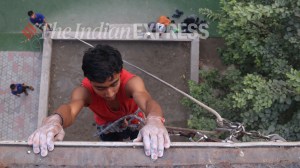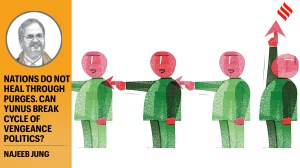P. Vaidyanathan Iyer is The Indian Express’s Managing Editor, and leads the newspaper’s reporting across the country. He writes on India’s political economy, and works closely with reporters exploring investigation in subjects where business and politics intersect. He was earlier the Resident Editor in Mumbai driving Maharashtra’s political and government coverage. He joined the newspaper in April 2008 as its National Business Editor in Delhi, reporting and leading the economy and policy coverage. He has won several accolades including the Ramnath Goenka Excellence in Journalism Award twice, the KC Kulish Award of Merit, and the Prem Bhatia Award for Political Reporting and Analysis. A member of the Pulitzer-winning International Consortium of Investigative Journalists (ICIJ), Vaidyanathan worked on several projects investigating offshore tax havens. He co-authored Panama Papers: The Untold India Story of the Trailblazing Offshore Investigation, published by Penguin. ... Read More
On rate cuts, RBI was cold, Govt had to turn on the heat
At a time when central banks in most countries are working in tandem with finance ministries to tackle the impact of a global meltdown...

At a time when central banks in most countries are working in tandem with finance ministries to tackle the impact of a global meltdown, the Reserve Bank of India and the government, it’s learnt, are not on the same page on the pace and extent of monetary actions required to stimulate the slowing economy.
In fact, the RBI’s last round of rate cuts on December 6 came after much pushing and prodding by the Government. And with most macro-economic indicators — except inflation — worsening, Government functionaries are bracing for another face-off with the central bank as they work out the next batch of cuts.
Prime Minister Manmohan Singh met RBI Governor Duvvuri Subbarao last Saturday to explore if the central bank can cut the repo rate — the rate at which the central bank lends money to banks — to 5.5 per cent from the current 6.5 per cent. To disincentivise banks from using the reverse repo window — banks parked Rs 20,000 crore every day on an average the whole of last week — the government is also keen that the reverse repo rate be reduced to 4.5 per cent from 5 per cent.
It has its task cut out.
For, sources said, in the last meeting of the apex committee chaired by the Prime Minister on December 2, Subbarao was not keen on cutting the repo rate arguing instead that a rate cut would weaken the rupee against the dollar that had already touched a low of 50. He is also said to have argued that a rate cut wouldn’t necessarily spur demand for credit.
At that meeting, sources said, Planning Commission Deputy Chairman Montek Singh Ahluwalia called for a sharp 200 basis points cut in repo rate and a 150 basis point cut in the reverse repo rate that had remained at 6 per cent since July 2006. Ahluwalia said it was important to signal to banks not to park excess moneys with the RBI by cutting the reverse repo rate.
Ahluwalia said despite RBI’s argument that liquidity was not an issue, banks remained averse to lend. But Subbarao indicated it was not the central bank’s function to direct banks to lend.
Finally, the apex committee prevailed upon the RBI that rates had to be cut. But after the RBI Governor headed back to Mumbai, the government learnt that Subbarao, after consulting his deputies, including Rakesh Mohan, was preparing for just a 50 basis point repo rate cut.
It was then communicated to him that the committee had decided on a 100 basis points cut in both repo and reverse repo rates. The cuts followed on December 6.
Since that meeting, the rupee has appreciated to 47.39 to the US dollar. Anecdotal evidence suggests that banks are averse to lending to the corporate sector though the RBI says demand for credit is slowing down. In fact, during the fortnight to November 21, bank credit actually fell Rs 2,193 crore. However, non-food bank credit, after a continuous decline in November, grew by Rs 7,650 crore for the fortnight ending December 5.
“The RBI is an autonomous regulator and the government respects it. But these are extraordinary times. World over, monetary policy authorities are working with the government. The US Fed has cut rates aggressively…it is now 0.25 per cent. Japan is thinking beyond 0 per cent rates now,” said a government functionary. “Inflation has almost halved to 6.8 per cent for the week ending December 3 from 12.91 per cent in August. A sharper repo rate cut is the need of the day.”




- 01
- 02
- 03
- 04
- 05




























